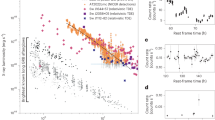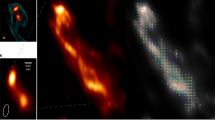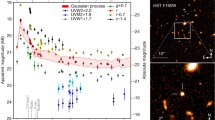Abstract
Most radio sources are two-sided, but a minority appear onesided, 3C273 being the first-known and brightest example. There is no agreement1–4 on whether such sources are intrinsically one-sided, or are normal double sources, one half of which is hidden by Doppler effects. We report here new radio observations at 408 MHz of 3C273 which show that the brightness of the postulated counter-jet is <1/100 of the brightness of the visible jet. If this ratio is due to Doppler beaming, the source must be seen almost end-on, and the whole jet must be moving at a quasi-relativistic speed (>0.7c) into an ambient medium with number density <0.6m−3. Because several arguments suggest that such a density is implausibly low, the jet of 3C273 cannot be identified with the radio lobe of a normal double source. If the emitting regions are moving slowly the ejection from the nucleus is certainly to one side only. An alternative possibility is that the jet is moving relativistically and behaves as one of the fast beams in the beam-model of Blandford and Rees5.
This is a preview of subscription content, access via your institution
Access options
Subscribe to this journal
Receive 51 print issues and online access
$199.00 per year
only $3.90 per issue
Buy this article
- Purchase on SpringerLink
- Instant access to full article PDF
Prices may be subject to local taxes which are calculated during checkout
Similar content being viewed by others
References
Scheuer, P. A. G. & Readhead, A. C. S. Nature 277, 182–185 (1979).
Blandford, R. D. & Königl, A. Astrophys. J. 232, 34–48 (1979).
Rees, M. J. IAU Symp. No. 94, 139–164 (1981).
Browne, I. W. A. et al. Mon. Not. R. astr. Soc. (in the press).
Blandford, R. D. & Rees, M. J. Mon. Not. R. astr. Soc. 169, 395–415 (1974).
Davies, J. G., Anderson, B. & Morison, I. Nature 288, 64–66 (1980).
Cornwell, T. J. & Wilkinson, P. N. Mon. Not. R. astr. Soc. 196, 1067–1086 (1981).
Arp, H. Proc. ESO/ESA Workshop SP- 162, 53–61 (1981).
Conway, R. G. & Stannard, D. Nature 255, 310–312 (1975).
Ray, T. P. Mon. Not. R. astr. Soc. 196, 195–207 (1981).
Pacholczyk, A. G. Radio Astrophysics (W. H. Freeman, San Francisco 1970).
Pearson, T. J. et al. Nature 290, 365–368 (1981).
Aaronson, M. et al Astrophys. J. 239, 12–37 (1980).
de Vaucouleurs, G. & Bollinger, G. Astrophys. J. 233, 433–452 (1979).
Lynden-Bell, D. Nature 270, 396–399 (1977).
Sherman, R. D. Astrophys. J. 246, 365–368 (1981).
Stockton, A. IAU Symp. 92, 89–97 (1980).
Silk, J. A. Rev. Astr. Astrophys. 11, 269–308 (1973).
Ulrich, M-H. Space Sci. Rev. 28, 89–104 (1981).
Conway, R. G. et al. Mon. Not. R. astr. Soc. 168, 137–162 (1974).
Author information
Authors and Affiliations
Rights and permissions
About this article
Cite this article
Conway, R., Davis, R., Foley, A. et al. Radio jet of 3C273. Nature 294, 540–542 (1981). https://doi.org/10.1038/294540a0
Received:
Accepted:
Issue date:
DOI: https://doi.org/10.1038/294540a0
This article is cited by
-
Large-scale superluminal motion in the quasar 3C273
Nature (1991)
-
The inner radio jet of 3C273
Nature (1988)
-
Particle acceleration in the hotspot of the jet of quasar 3C273
Nature (1986)
-
The jet of the Quasar 3C 273
Journal of Astrophysics and Astronomy (1986)
-
Radio emission from the jet and lobe of 3C273
Nature (1985)



